-
232012. 03
No. 74 View. 7926
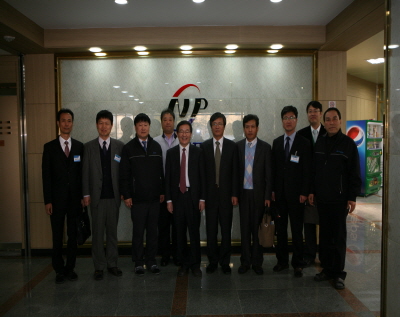
KISTI On-the-spot visit to to support SMEs
Dr.Park Young-seo,President and some researchers of KISTI have started their on-sight visiting program to SMEs on March 20th as an attempt to understand the need of SMEs on the spot and to provide 1-1 consulting services. In 2011, Dr.Park and some of researchers from KISTI's 3 main centers, information dissemination, information and supercomputing centers, paid visit to 100 SMEs and had interview with CEOs and research staffs to learn about what they really want from pubic research institutes. As a result of the interview with SMEs, KISTI has set up 1-1 consulting program and designated 1 researcher to 1 company who has suitable academic background for the need of SMEs. in 2012, KISTI will also visit about 50 SMEs and will provide every possible resources to support SMEs in developing new technology or advancing into new market. -
202012. 03
No. 73 View. 8425
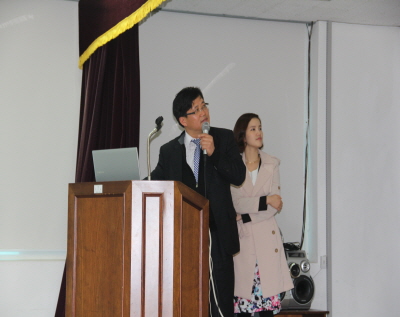
Knowledge donation for students
KISTI started its knowledge donation for students in 2012. At the beginning of this year, KISTI surveyed the need for knowledge donation from 16 offices of education and received about 500 applications. Among them, KISTI has chosen 20 schools which are mostly located in provincial areas where students are not easy to enjoy scientific and educational benefits. On March 16th, Mr.Kim Byung-jung, Deputy director of KISTI Busan branch office and2 KISTI staff have visited 2 schools located in KyungNam Province and gave a lecture on science and technology customized for students. KISTI will strengthen its knowledge donation for students this year and will develop various donation programs for students. -
282012. 02
No. 72 View. 8410
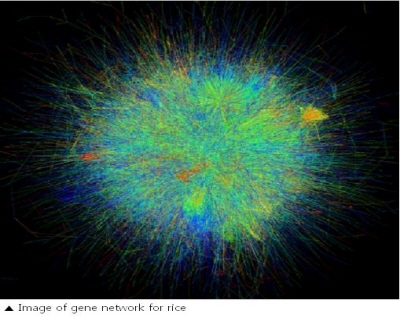
Gene social network for rice, one of world's four major grains, identified
Korean researchers have led a study to identify a gene social network for rice, one of the world's four major grains.? This gene social network study was published in the Proceedings of the National Academy of Sciences on October 31. The study was led by Prof. Lee In-suk at Yonsei University, with participation of Prof. Pamela Ronald from the University of California, Prof. Edward Marcotte of the University of Texas in the U.S., and Prof. Seo Young-su at Pusan National University in Korea. The study was conducted with the support of the "Veteran Researcher Assistance (Leap Research)" program, which is managed by the Ministry of Education, Science and Technology (Minister Lee Ju-ho) and the National Research Foundation of Korea (Chairman Oh Se-jung). The study was published online first in the October 31 issue of the Proceedings of the National Academy of Sciences, a prestigious international science journal. The study was titled 'Genetic dissection of the biotic stress response using a genome-scale gene network for rice.' Prof. Lee's team constructed a gene social network that interlinks 20,000 genes, or half of all rice genes, for the first time in a commercial crop and discovered new genes (rox 1, 2 and 3), which are important to its resistance to diseases and insects by using the network. Prof. Lee has also constructed gene social networks for yeast, a micro organism (Science 2004), eelworm (Nature Genetics 2008), Arabidopsis thaliana, a plant model (Nature Biotechnology 2010), and humans (Genome Research 2011). He has thus demonstrated that scientists can effectively predict and discover new genes that will be important to disease resistance in humans and to the resistance of plants to the environment.? Notably, Prof. Lee this time constructed a gene network for rice, a commercial crop, and demonstrated that a gene research technique based on networks can be an important solution to addressing the food, energy, and environmental problems of the world going forwards. The research team also successfully discovered three rox genes, which play a critical role in improving a plant's resistance to diseases and insects, by conducting tests of only five candidate genes using the network. This is a method that thus allows scientists to discover the functions of new genes in a greatly more efficient manner (12-fold efficiency increase), when compared with the conventional genetic research method based on a random search. Prof. Lee said, "The study is a success wherein we completed a gene social network for rice and discovered genes that are resistant to certain harmful environments, including drought, diseases and insects, by using the network. We also demonstrated the possibility for the development of transgenic crops." He added, "Such a gene network is expected to bring about revolutionary advances in research on agriculture and bio energy in the future." Source - Hellodd.com -
282012. 02
No. 71 View. 8072 KISTI, Hannam University and ASTI(Association of Science and Technology) agreed to cooperate for raising digital manufacturing specialists utilizing supercomputer on Feb.21st at KISTI head office. Heads of three organizations shared their experience and opinions on difficult situation of SMEs due to the shortage of specialized manpower. During the meeting, Dr.Lee Sang-min introduced KISTI's supporting program for "Training program for advanced design utilizing supercomputer". Dr.Park Young-seo emphasized the importance of SMEs in Korea and KISTI will not save any efforts in promoting the competitiveness of SMEs. Dr.Kim Hyung-tae, President of Hannam University also said that this kind of tripartite cooperation among industry, university and research institute in raising specialists for regional economy will set a firm foundation for supporting SMEs.

-
202012. 02
No. 70 View. 7655 KISTI held opening ceremony for EDISON CENTER at its head office in Feb.15th. EDISON is a short of Education-research Integration through Simulation On the Net and is designed to make students and graduate students of science and engineering area enable to utilize and simulate up-to-date research results on On-line. KISTI will provide them with EDISON platform connected with high-performance research network and research results in thermofluid and energy,chemistry,structural analysis and dynamics and Nano materials are available for use. Dr.Park young-seo,President of KISTI said that KISTI will support and strengthen its support for students and graduate students of science and engineering area by expanding and upgrading EDISON platform and its software.
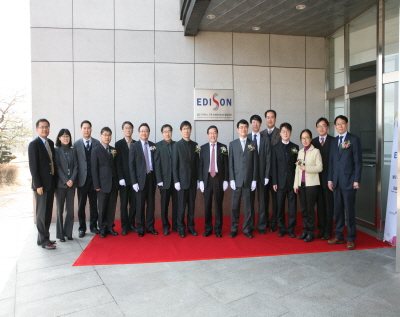
-
162012. 02
No. 69 View. 8823
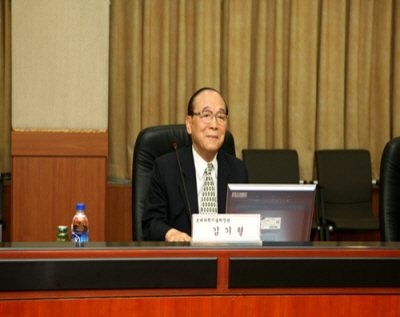
'Fundamental technology for hot electron solar cell' developed
KAIST Prof. Park Jung-yeong's team publishes study in September 14 issue of 'Nano Letters' a leading nano science journal The National Research Foundation of Korea (Chairman: Oh Se-jung) said, on October 6, that Korean scientists had developed a fundamental technology for hot electron solar cells that are created by absorbing solar light. The study was led by Prof. Park Jeong-young at the EEWS Graduate School in the Korea Advanced Institute of Science and Technology (KAIST, President: Suh Nam-pyo) and was assisted by master's program student Lee Young-keun and doctoral student Jung Chan-ho. Prof. Park's team detected hot electrons generated on the surface of nanodiode by light by using a nanodiode that consisted of a metal thin film and a metal oxide semiconductor, and transformed them into a nanosome measuring dozens of nanometers through surface treatment of the metal thin film of the nanodiode. This nanosome displayed a surface plasmon. The research team measured the hot electrons detected on nanodiode, and thus examined the amplification of hot electrons due to a surface plasmon. This suggested that a surface plasmon maximizes the generation of hot electrons, and this principle can be applied to increasing the efficiency of solar cells. Prof. Park said, "Accurately understanding and measuring hot electron is very important in surface science and energy engineering because it allows us to fundamentally understand the process of energy loss. The development of this fundamental technology related to hot electrons is expected to have applications in the development of high efficiency transformation devices." The study was published online first on September 14 in Nano Letters, a prestigious journal in the nano science field. #?Glossary o Hot electronHot electrons are generated on the surface due to energy conversion process when energy is transferred to the surface from outside. In this process, external energy entails various phenomena, including chemical reactions, such as the absorption of light, the absorption of molecules and catalytic reactions, or the colliding of electrons or ions. Converted energy allows for the flow of hot electrons on the surface. The detection of such hot electrons is possible by using a nanodiode comprised of a thin film oxide. Understanding and measuring these hot electrons holds significance in that it allows the process of energy loss at the molecular level to be better understood. o Surface PlasmonThis refers to quasi particles in which free electrons vibrate collectively on the surface of a metal. The phenomenon whereby light is contained on the surface of a metal, due to the interaction of light and free electrons within the metal, is called surface plasmon resonance. As a result of this surface plasmon resonance, the intensity of the metal?s electromagnetic field increases. The cross-section where light is absorbed by a metal changes due to a surface plasmon, and as a result, the penetration ratio of light changes at a certain wavelength at which the surface plasmon is visible. o Nanodiode A nanodiode is comprised of a metal thin film and semiconductor (oxide semiconductor or compound semiconductor), and it refers to the concept that hot electrons emerge on the surface of nanodiode before they are detected by overcoming Schottky energy barrier. Source - Hellodd.com -
162012. 02
No. 68 View. 7978 Using radioactive ray-mutation technology; 1st year cultivation under review The Korea Atomic Energy Research Institute (President: Jung Youn-ho) said, on September 27, that it had developed a new kenaf breed dubbed "Jangdae," which grows very well and whose seeds can be collected domestically, by using a radioactive ray-mutation breeding technique. Researchers led by Dr. Kang Shi-yong, in the radioactive ray-mutation breeding research team at the institute's Jeongeup Advanced Radiation Technology Institute, exposed kenaf collected from the Jinju region from 2003 to gamma rays and developed the new breed "Jangdae," which grows better than the original breed and whose seeds can be collected in Korean climate. Kenaf is an annual grass plant originating in West Africa and is one of the world's top three fiber plants. It is known as a botanical resource for various bio materials. Growing fast and consuming large volumes of carbon dioxide, the plant is also an eco-friendly industrial material for high-end paper, eco-friendly wall paper, construction boards, bio plastic, automobile frames and functional clothing.? Jangdae has been developed with research funds from the Life Industry Technology Development Program, under the Ministry of Food, Agriculture and Fisheries, and is being cultivated for demonstration at the pilot breeding farm at the Jeongeup Advanced Radiation Technology Institute. The application to register Jangdae for protection as a new breed has been completed, and first year cultivation review is underway at the pilot farming site at the Korea Seed and Variety Service. Tests have also been conducted to review the natural growing and anthesis trends under a mass cultivation environment in the Saemangeum reclaimed area in Gimje, North Jeolla Province. In Korea, research was conducted on pilot cultivation and the use kenaf in the production of sags that would replace rice thatch sags as containing grains in the 1960s, but the study was halted following the introduction of chemical sags in the early 1970s. Recently, amid growing interest in products sourced from kenaf, related research has been conducted sporadically, but researchers have had difficulties due to lack of a domestic breed. Imported kenaf grows relatively well in the weather conditions in Korea and yields a high bio mass. Because the foreign breed only blooms for anthesis in a tropical climate, however, it has been impossible to procure seeds, and thus it was difficult to re-cultivate the plant domestically.?? The domestic development of Jangdae has made it possible to gather seeds and re-cultivate the species in the climatic conditions in Korea, opening up the possibility for kenaf's wide use as an eco-friendly industrial and functional material. Also, domestic development of the breed also reduces the expenses associated with seed license royalties and helps increase income for farming households, while allowing Korea to generate income through its export to foreign countries. Once Jangdae is registered as a new breed, KAERI will seek the mass production and introduction of the new breed in Korea. Trial cultivation is underway at the pilot farming site in the Saemangeum Reclamation Area in Gimje in collaboration with the Jeollabuk-do Agricultural Research & Extension Service. A plan has been set up for the mass cultivation of the breed, in cooperation with farming cooperatives, next year. Dr. Kang said, "We will continue developing additional kenaf breeds that are suitable for cultivation in Korea and construct a mass production system." Lim Eun-jeong, Hello DD watercurve@daum.net ?
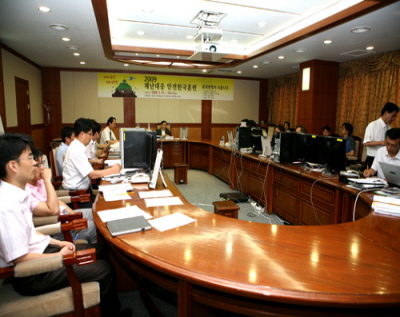
-
162012. 02
No. 67 View. 8499
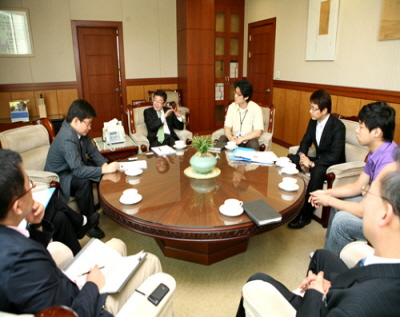
Scientists develop carbon dioxide capture process using a separation membrane
Korea Institute of Energy Research gains upper hand in quest to produce hydrogen by removing carbon dioxide from coal The Korea Institute of Energy Research (President Hwang Ju-ho) said, on August 31, that it had developed an "integrated processing technology for carbon dioxide capture using a separation membrane", which allows for the complete removal of carbon dioxide from the coal frequently used in thermal power plants and for the mass production of hydrogen, a future clean energy. It added that it had also secured globally leading technology through demonstration.? The new technology is significant on two grounds. Firstly, it allows for the use of low grade hydrocarbon fuels, including coal, waste and biomass, and the environment-friendly use of coal, which is stably low-priced and evenly distributed worldwide, by significantly reducing carbon dioxide emissions. Secondly, it constitutes a new technology for producing future energy, which will allow for the production of large volumes of hydrogen to advance the era of the hydrogen economy. The process, which is applied to integrated gasification combined cycle (IGCC) power plants, converts synthesis gas made from carbon monoxide and hydrogen, which is produced by a gasification device, into carbon dioxide and hydrogen. The hydrogen is then selectively filtered out through a separation membrane and the carbon dioxide captured. The hydrogen can be stored and used for fuel cell power generation and transport, while the carbon dioxide can be stored underground or at other sites. ? The Pd-Cu separation membrane, developed independently by the institute, is a fundamental core technology that ensures the efficiency of the process and allows for outstanding performance and low a capture cost. The new membrane has more over a seven times capacity to process synthesis gas than conventional separation membranes. In addition, the use of expensive materials is reduced to cut production costs when using the ultra-thin membrane.? Additionally, the module comprised of membrane layers is designed to withstand over 30 times normal atmospheric pressure. The institute has thus secured the technology to produce modules of high pressure membranes. The technology was designed to use the pressure generated in the gasification device as is, and thus enhance filtering capacity, and is more efficient than other capture technologies that incur energy losses due to a gap in pressure, while simplifying the process. The institute succeeded in demonstrating the new technology by using a laboratory scale process capable of processing 2 liters of gas per minute and by developing a pilot facility it had created on its own, which has the capacity to process 1,000 liters of hydrocarbon per hour. Dr. Baek Il-hyun, principal investigator, said,? "We have secured technological supremacy and economic viability in the carbon capture and storage (CCS) field, an area highly competitive in terms of technological development. The new technology constitutes a next generation energy technology that can not only fundamentally remove the carbon dioxide generated by fossil fuel but also allow for the mass production of hydrogen, a clean energy." The development of the "integrated process for capturing carbon dioxide using a separation membrane" will serve as a catalyst for the development of low-cost carbon capture technologies. Going forward, the institute aims to advance the commercialization of this process through a phase 2 project, which is interlinked with the coal gasification system. If the technology is successfully commercialized and applied to domestic power plants by 2025, when the CCS facilities market is expected to expand, it will effectively cut 2.2 million tons of carbon dioxide emissions per year and generate economic ripple effects by allowing Korea to gain the upper hand in the 740 billion-won domestic market and 2.6 trillion-won export market. Source - Hellodd.com -
072012. 02
No. 66 View. 7035
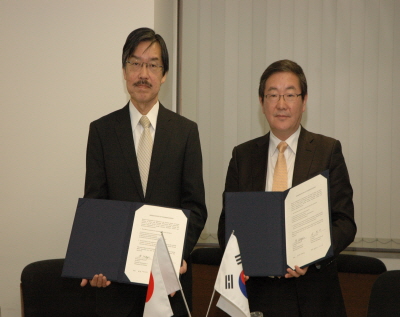
KISTI shook hands with ROIS in Japan
KISTI has concluded MOU with ROIS(Research Organization of Information and Systems) on Feb.6th in Japan. This MoU is to promote exchange of researchers and professors, conduct global research collaboration, organize international conference, share science and technology informaiton. ROIS is research council founded in 2004 in collaboration with NII, ISM, NIG,TRIC,DBCLS,NIPR and is advancing fusion research on the polar regions, telecomunications,statistic mathematics and genetics into world-class level. Dr.Park Young-seo,President of KISTI said that this MoU will establish firm foundation for joint application and dissemination of knowledge information in science and technology and ROIS will wokr as KISTI's global partner in producing value-added information, upgrading reserch environment and commercializing R&D products. -
022012. 02
No. 65 View. 6515 The 2011 ASTI CTO meeting in Chungchung Province was held on Jan.12th at Adria Hotel in Yusung. About 50 CTO memebers of Daejeon and Chungchung province were participating in the meeting and shared economic trend and business strategy together with new-year-greetings. Dr. Park has given a lecture to the participants with a title of " 2012 Global economic environment and issues". Dr.Park explained that future technology will be created by merging with new technologies and the influence of SNS will be increased more than ever. He also emphasized that there will be lots of uncertain factors in economic situations this year but we can get over with more active communications and aggressive strategy.
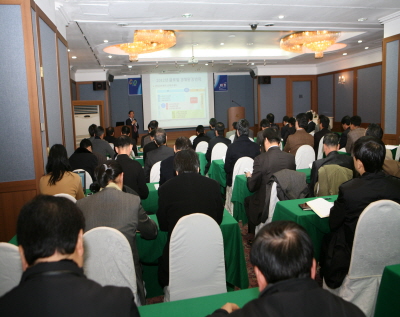

 Delete Article!
Delete Article!